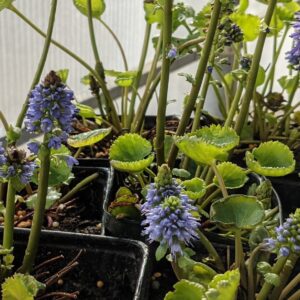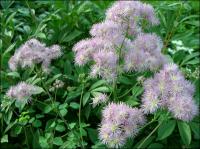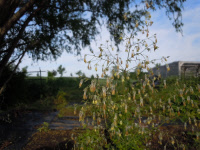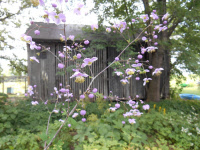Plants for Butterflies and Other Pollinators
Showing 201–208 of 223 results
-
Synthyris missourica Mountain Kittentails Z 5-9
Spring flowering, true blue short stalks above leathery, evergreen leaves, circular with tooth margins.
OUT OF STOCK
Spring flowering, true blue short stalks above leathery, evergreen leaves, circular with tooth margins.
Size: 5-12” x 12” spreading into clumps by rhizomes.
Care: sun to part shade in moist to moist well-drained soil
Native: Mountains of northeast CA, Washington, Idaho & west to MontanaCollected by Meriwether Lewis on June 26, 1806 in today’s Idaho near the headwaters of what they named Hungry Creek. Common name kittentails imaginatively named for the flower stalk and its protruding stamens resembling, if you squint real hard and maybe after taking a swig of whiskey, fuzzy, blue kitten tails.
-
Teucrium hircanicum syn. T hyrcanicum Iranian germander, Purple Tails, Wood Sage Z 5-8
Loads of deep purple erect spikes from mid-summer through fall making this subshrub one of the best
Loads of deep purple erect spikes from mid-summer through fall making this subshrub one of the best
Size: 18-24” x 24”
Care: sun in moist well-drained to well-drained soil
Native: Caucausus and Iran
Wildlife Value: attract butterflies, deer resistantDescribed and named by 1753
-
Thalictrum aquilegifolium Meadowrue, Feathered columbine Z 5-9
Delicate lavender to pink panicles of showy stamens in early summer
Delicate lavender to pink panicles of showy stamens in early summer
Size: 36" x 18"
Care: Sun to part shade in moist humusy soil
Native: Europe and North Asia
Wildlife Value: attracts Black swallowtail butterflyThalictrum is from Greek meaning “to flourish” or “look green.” In 1629 Parkinson, apothecary to James I and later, botanist to Charles I, called this “Tufted columbine” a descriptive name, the flowers are tufted, and the leaves resemble those of a columbine. Ancient Romans used it to cure ulcers, the plague and “the Faundife.” Romans stuffed children’s’ pillows with the flowers to bring them wealth. Liberty Hyde Bailey described Thalictrum aquilegifolium as: “A good garden plant and frequently planted,”(1933). Cultivated in U.S. since 1700’s.
-
Thalictrum coriaceum Maid of the Mist Z 5-7
Broad panicle of white flowers with maroon-colored filaments and tips of stigma flowering May to June
Broad panicle of white flowers with maroon-colored filaments and tips of stigma flowering May to June
Size: 3-5’ x 2’
Care: sun to shade in moist to moist well-drained soil
Native: Uncommon, central and southern Appalachian endemic, Pennsylvania to northern Georgia west to West Virginia and Tennessee, primarily in the mountainsFirst described in 1891 in “Torrey Bot. Club” 18:363, 1891. Collected on Rock Table and Stone Mountains in North Carolina in 1891 by J.K. Small (1869-1938) and A.A. Heller and by “Professor Porter in the same region many years before.”
-
Thalictrum delavayi Yunnan meadow rue Z 4-7
Purple to lavender flowers of sepals and stamens from July to August. Delicate-looking leaflets smaller than on most other Meadowrues. One of internationally known garden designer Piet Oudolf’s 100 “MUST HAVE” plants, Gardens Illustrated 94 (2013)
OUT OF STOCK
Purple to lavender flowers of sepals and stamens from July to August. Delicate-looking leaflets smaller than on most other Meadowrues. One of internationally known garden designer Piet Oudolf’s 100 “MUST HAVE” plants, Gardens Illustrated 94 (2013)
Size: 30” x 20”
Care: sun - part shade in moist humusy soil
Native: Tibet and China
Wildlife Value: Attracts Black swallowtail butterfly
Awards: England’s Royal Horticultural Society Award of Garden Merit.Thalictrum is from Greek meaning “to flourish” or “look green.” This species discovered by and named for Pére Jean Delavay (1838-1895), French missionary to China. Delavay found about 1500 new species in his three (3) trips to China. He sent his discoveries to the Jardin des Plantes in Paris. In 1880 he contracted bubonic plague while in China, which disabled him the remainder of his life.
-
Thalictrum minus ‘Adiantifolium’ Fernleaf meadowrue Z 4-8
Loose panicles of tiny yellowish flowers top fern-like foliage in mid-summer.
Loose panicles of tiny yellowish flowers top fern-like foliage in mid-summer.
Size: 36" x 24"
Care: part shade in moist to moist well-drained soil.
Native: Europe, North Africa & Siberia
Wildlife Value: Attracts Black swallowtail butterfly, Deer resistant.
Awards: Rated as excellent by the Chicago Botanic Garden.Thalictrum is from Greek meaning “to flourish” or “look green.” The species grown by Gerard in the 1590’s.
-
Thalictrum polygamum syn. T. pubescens Tall Meadowrue, King of the meadow Z. 4-8
Showy, delicate ivory stamens July to September
OUT OF STOCK
Showy, delicate ivory stamens July to September
Size: 3-8’ x 4’
Care: part shade to shade in moist to moist well-drained soil.
Native: Newfoundland west to the Mississippi River & south to Mississippi, WI
Wildlife Value: Attracts Black swallowtail butterfly
Awards: Rated as “excellent” by the Chicago Botanic Garden
Size: Iroquois smashed this Meadowrue to wash their heads and necks for nosebleeds. They also used it to remedy gall ailments. For the Montagnais its leaves flavored salmon.Thalictrum is from Greek meaning “to flourish” or “look green.” Iroquois smashed this Meadowrue to wash their heads and necks for nosebleeds. They also used it to remedy gall ailments. For the Montagnais its leaves flavored salmon. Collected before 1793. Grown at America’s 1st botanic garden, Elgin Botanic Garden 1811. Pressed specimen in Emily Dickinson’s herbarium.
-
Thalictrum rochebruneanum Lavender mist meadowrue Z 4-7
Lacy, fine-textured, bluish-green, pinnately compound, columbine-like foliage topped by pendulous, lavender-purple flowers (sepals) with yellow stamens July-September in airy clusters rising well above the foliage to 4-6' tall. Extraordinary en mass. One of internationally known garden designer Piet Oudolf's 100 "MUST HAVE" plants, Gardens Illustrated.
OUT OF STOCK
Lacy, fine-textured, bluish-green, pinnately compound, columbine-like foliage topped by pendulous, lavender-purple flowers (sepals) with yellow stamens July-September in airy clusters rising well above the foliage to 4-6′ tall. Extraordinary en mass. One of internationally known garden designer Piet Oudolf’s 100 “MUST HAVE” plants, Gardens Illustrated.
Size: 6’ x 30”
Care: sun to part shade in moist well-drained soil
Native: Japan
Wildlife Value: Attracts Black swallowtail butterfly
Awards: Missouri Botanic Garden Plant of MeritThalictrum is from Greek meaning “to flourish” or “look green.” This species collected before 1878. Likely named for French botanist Alphonse Trémeau de Rochebrune (1834-1912).






